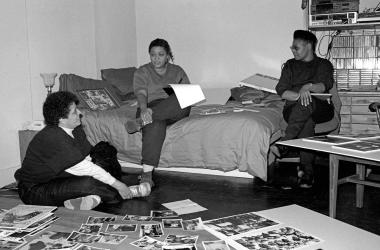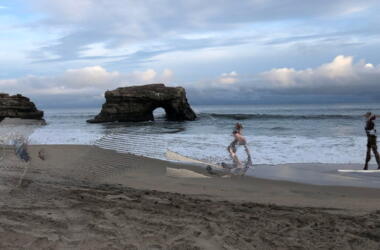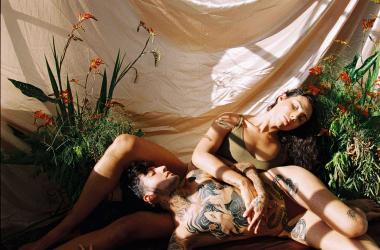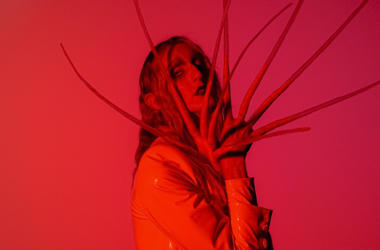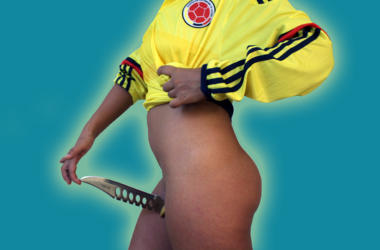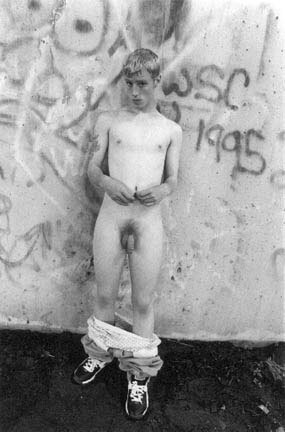
Image
AMOS BADERTSCHER Untitled, 2001/2002 Silver gelatin print 8 x 10"
PAST
ILLEGAL TO SEE: A Portrait of Hustler Culture by Photographer Amos Badertscher
Mar 15, 2005 - Apr 23, 2005
ILLEGAL TO SEE: The Outsider Art of Amos Badertscher
by Gary Scharfman
(from THE ARCHIVE: No. 15: Winter 2005)
Photographer Amos Badertscher pushes peoples’ buttons. His body of work includes photographs of delicate landscapes, exquisite still lifes and raunchy drag queens. However, it is his documentary imagery that centers on the young hustlers of his native Baltimore that disturbs one’s equilibrium. Hustler culture is Badertscher’s obsession and it is what informs his solo exhibition at LLGAF, “Illegal to See–The Outsider Art of Amos Badertscher.”
Originally mounted in June 2004 at CEPA (Center for Exploratory and Perceptual Art) in Buffalo, New York, “Illegal to See” was part of ”Deviant Bodies,” a major exhibition that explored the margins of contemporary gay male culture. The images in “Illegal to See” stretch from the1970s to the present day. This collection of 57 gelatin silver prints only hints at the larger body of work created by Badertscher over the past 30 plus years.
One explanation of what is at stake in Badertscher’s images is summed up by Mack Friedman (Lambda Literary Award Finalist for Strapped For Cash A History of American Hustler Culture) in his essay that accompanies this exhibit:
“When I look at Amos Badertscher’s work, I feel like I’m hustling again. To me it’s like his camera’s an occult mirror reflecting the light from his subjects’ skin into the darker corners of my past. The desperation in their eyes is two shades too familiar. The embarrassment of their smiles, my own. Freshly gained manhood sticks proudly out of their zippers, a memory. The complacent tilt of their hips is all mine. In his portraits, Amos possesses the historically dispossessed. In doing so, and in doing so simply, he makes street hustlers starkly real, neither heroes nor martyrs. He flashes on society’s margins, illuminates what we neglect to examine, and reminds us what it’s like to be young and lost. He shows us our objects of desire, first, and then our shame, and he makes us own them both.”
Now on the cusp of 70, Badertscher reflects upon his experience growing up in the very comfortable Baltimore suburb of Towson:
“There must have been something dangerously lacking in my upper-middle-class psyche because I did not find nudity, even youthful male nudity shocking, abusive emasculating, pornographic or subversive. To photograph the naked body is, for me, the ultimate dimension in photographing the person. The way the good father (or god, bless his perverse heart) made it.”
In my introduction to Badertscher, a collection of his photographs published in 1998 by St. Martin’s Press, I wrote about the artist and his technique:
“He is a shy and impatient man easily exasperated by the mundane demands of daily life. However, when in pursuit of a subject to photograph, Badertscher is intrepid…Badertscher’s preferred photographic technique is rapid, unrehearsed sessions. He does not see himself as a photographer who visualizes or plans things out in advance. Badertscher relies on instinct and what he considers to be the many possibilities presented to him in the darkroom.”
A self-taught photographer, Badertscher credits a fellow faculty member at a prep school where he taught mathematics in the 1960s of awakening him to the medium’s possibilities: “This teacher, who had a lot of background in photography, got right up to the subject, all the while managing to relax the model; what got me was to see all that personality captured in film.”
A modest inheritance in 1975 enabled Badertscher to fully concentrate his energies on photographing his friends, along with the hustlers and what he considered to be the wonderfully outrageous people who populated the expanding number of gay bars that sprouted up in Baltimore since the sixties. He readily acknowledges that: “From my family’s point of view it was a wasted life, but from mine it was very gratifying.”
For the better part of twenty years his work was ignored. According to Badertscher: “During this time the images I was amassing grew into a photographic chronicle not only of myself but of a world easily invisible to mainstream sensibility. I wish I could think of a more vicious way to describe this convenient blindness but I can’t.”
By 1993, he was resigned to putting his home up for sale. One of the prospects whom the real-estate agent brought over was Michael Mezzatesta, the director of the Duke University Museum of Art, who was considering relocated to Baltimore from North Carolina. Mezzatesta and his wife toured through rooms whose walls had over the years become blanketed with Badertscher’s photography. It was an eye opener.
As it turned out Mezzatesta and his wife did not buy the house, nor did they relocate to Baltimore. Instead, in 1995, Badertscher was given a solo exhibition at the Duke University Museum of Art.
In his forward to Baltimore Portraits, a monograph of Badertscher’s photography that evolved out of that exhibition and published in 1999 by Duke University Press, Mezzatesta commented on the universality of the imagery: “Although the subject of Badertscher’s lens has been Baltimore, his sitters are hardly unique to that city. They could have been found in thousands of cities across the United States where lives are being lost to substance abuse, family breakups, alcohol, drugs, AIDS, sexual prejudice, and intolerance. As the artist points out, not only is it a tragedy that we are losing these lives, but perhaps the greater tragedy is that no one seems to care. Amos Badertscher has humanized people we might never encounter or think about, conveying not only the tragedy of lives lost but also the indomitable drive of the spirit to make itself known.”
In his introductory essay to Baltimore Portraits, Tyler Curtain, at that time Visiting Scholar in the English Department at Duke University observed: “Badertscher’s art takes the feel, the excitement, of a trick and transfers it to the surface of the photo. It’s an extraordinary, arresting effect. The photographs perform the intimacy of a crowded gay bar or strip club: immediately sexually charged, when you touch them they discharge the shock of familiarity of the skin of someone you’ve just met through never known.”
In explaining Badertscher’s perception of where these people fit in the current gay rights movement, Curtain states: “Badertscher believes that it is easy to moralize about the complexities of the lives of people who live on a hard edge. To his eyes, the political (and, indeed, moral) failings of the gay and lesbian community are located in an attitude that wants to play the complexities of drugs, familial abuse, disease and sexual power against an attitude of social respectability. Political expediency is bought with the blood of people who are written off as alienated by their own ‘perversions’.”
Most of the portraits that make up this show contain incisive biographical narratives that Badertscher scrawls on the white border surrounding the images. Among other things, they reveal fluidity in the sexual identity of the hustlers and their attempts at creating even fleeting stability in their lives: “Danny L. (born 1982) has been pretty much on the street, using drugs + hustling men, probably from the age of 10 or 12. Today, this is his sole employment. He has had throughout the years, several girlfriends (some also on heroin) and two sons, one born in 2000 and one in 2001. Despite this arrangement, Danny freely admits his bisexuality and his attraction to men and some male peers. Immature, impractical and emotionally fragile, he has lived at countless locations since 15 and has attempted suicide a number of times, particularly when his girlfriend threatens to leave him. Sexuality is totally fluid and he prefers older men who will ensure continuing shelter and drugs.”
In his review of the CEPA exhibition, critic Richard Huntington of the Buffalo News, observed: “Badertscher manages to bring these grim portraits to an emotional steady point, and after a time the sheer repetition of the erotic poses and the gray, low tech look of the images drowns any pornographic thrust in a plaintive plea for witnesses to these sad lives.”
The tone and content of the biographical narratives clearly reveal Badertscher as a passionate social critic of the status quo. However, he makes no pretense of being a means to anyone’s salvation. (Badertscher is no modern day William Gladstone trying to convince the prostitutes of 19th century London to mend their ways.) This is perhaps most palpable in Badertscher’s series of portraits framed before a mirror where he is often both photographer and participant. It does not take a stretch of the imagination to infer that while the hustlers are his models, he is as likely to be their (satisfied) client.
In conclusion, Friedman’s essay notes that Badertscher is: “Never sentimental, with terse and brutal subtlety, Badertscher mines the sub terrain and shines his flashlight on its shadows. He turns his camera to the shade of underpass and shows us what’s happening right under our noses, forces us to examine what we might ordinarily ignore, condemn, legislate against, and even make illegal to see.”
Illegal to See–The Outsider Art of Amos Badertscher opens Tues. Mar 15, 2005 6pm and continues through Sat. Apr 23, 2005. The Exhibition has been curated by Degen-Scharfman.





